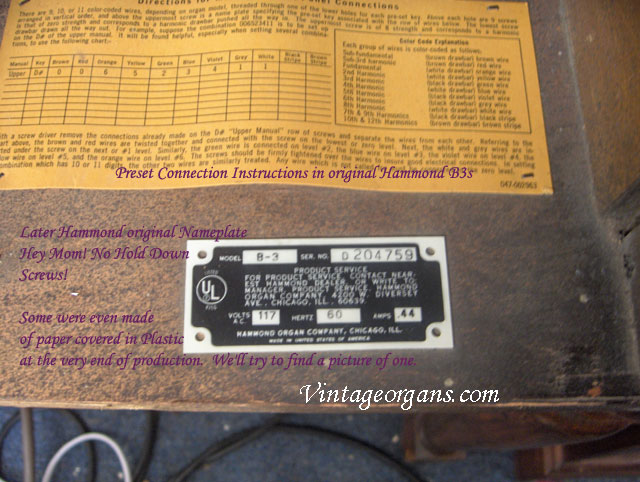
Most Hammond organs do not have a full, 32-note American Guild of Organists pedalboard going up to a G (3rd leger line of the bass clef) as the top note.
#Hammond organ serial numbers manuals
The lightweight construction of the 'waterfall'-style keyboard for the upper manuals allows for very rapid passages to be executed with more ease than on a weighted keyboard, such as a piano or pipe organ. The resulting tones are ultimately amplified and converted to sound by a loudspeaker. The organist selects these tones via the drawbar circuitry and the keyboards while playing the organ. The bumps in the edge of the tone wheel cause the magnetic field of the pickup to vary, generating a periodic voltage change in the pickup's coil-a tone. An electromagnetic pickup is placed next to each tone wheel. The entire gear train rotates continuously. The gear ratios determine each wheel's rotation speed.

A synchronous motor turns the wheels through a set of axles and gears. The number of bumps and the rotation speed of the wheel determines the tone's frequency. Each tonewheel has a number of bumps along its edge. Each key on the keyboard can control up to nine tones, depending on the drawbar settings or drawbar presets. There are one of these wheels for each of the ninety-one tones the organ can produce. The sound reproduction system is based on tonewheels. Soon, the Leslie speaker cabinet's signature sound became a de facto requirement for Hammond enthusiasts. As well, the Leslie speaker cabinets', the valve amplifier gave the Hammond's tone a warm, natural 'overdriven' sound, which could be varied from a mild 'purr' to a heavily overdriven growl. The Leslie speakers had a rotating horn and a stationary bass speaker with a rotating baffle that produced a vibrato effect.

Speakers originally designed by Don Leslie were widely used with the Hammond organs, though at first, Leslie was a competing company that Hammond sought to drive out of business. The distinctive 'key click' that was originally a design flaw rapidly became part of the 'Hammond sound', which modern imitations of the Hammond organ try to reproduce. Other features added to Hammond organs included an electromechanical vibrato and, by the late 1950s, a reverb effect which simulated the reverberation of a large church hall. The drawbars, which operate like the faders on an audio mixing board, allow the performer to vary the volume of each notes' fundamental tone, the octave below it, and the octaves and harmonics above it.

The component waveforms can be mixed in varying ratios by using 'drawbars' mounted above the two keyboards. Although they are generally included in the category of electronic organs, strictly speaking, because the waveforms are produced by mechanical tonewheels rather than electronic oscillators, original Hammond organs are electromechanical rather than electronic organs. As in Thaddeus Cahill's earlier Telharmonium, the individual waveforms were made by mechanical 'tonewheels' which rotated beneath electromagnetic pickups.
#Hammond organ serial numbers series
In imitation of a pipe organ, with its banks of pipes in multiple registers, the Hammond Organ used additive synthesis of waveforms from harmonic series to generate its sounds. It was widely used in United States military chapels during the Second World War, and returning soldiers' familiarity with the instrument may have helped contribute to its popularity in the post-war period.

While the Hammond organ was originally sold to churches as a low-cost alternative to the pipe organ, it came to be used for jazz, blues, and to a lesser extent rock music (in the 1960s and 1970s) and gospel music. The Hammond organ is an electric organ which was designed and built by Laurens Hammond in April 1935.


 0 kommentar(er)
0 kommentar(er)
